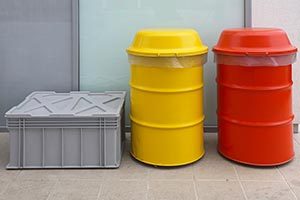
If you are a builder, contractor or developer and are planning a construction or renovation project in the Monterey, California area, M3 Environmental LLC can advise and assist you in developing a Hazardous Waste Mitigation Plan that complies with both federal and California state requirements.
Dealing With Construction Or Demolition Waste
Having an overall waste management plan that reduces waste and minimizes the impact on landfills by removal of salvage for reuse or recycling is certainly advisable. It is critical to incorporate a plan for mitigating hazardous waste to comply with federal and state regulations and avoid significant fines and penalties.
Identifying Hazardous Waste
First, identifying hazardous waste is extremely important, and failure to do so can result in federal violations and fines. Types of hazardous waste commonly produced at construction or demolition sites include:
- Asbestos
- Lead
- Unused Paint
- Mercury Waste
- Solvent & Thinner
- Petroleum Products
- Unpunctured Aerosol Cans
- Fluorescent & Energy Saving Light Bulbs
- Septic Waste
Federal Regulations
Most construction, demolition and renovation sites fall under the federal classification of Conditionally Exempt Small Quantity Generators. While you may be exempt from many requirements, others are mandatory. Also, some federal exemptions may be necessary under California state regulations. Even if you are exempt from some requirements, it may be wise to include them in your Hazardous Waste Mitigation Plan. M3 Environmental LLC can help you navigate these regulations in formulating your plan.
Creating Your Plan
Your Hazardous Waste Mitigation Plan should include procedures for at least the following in preparing for and reducing hazardous waste:
- Solid Hazardous Waste
- Liquid Hazardous Waste
- Fuel & Hazardous Waste Storage
- Stormwater Management
- Hazardous Waste Disposal
While the project manager or general contractor is ultimately responsible for complying with government requirements, your emergency plan should also provide for training of all project personnel in recognizing hazardous wastes and responding appropriately to protect the environment and ensure safety.
Preventing Spills
Measures to prevent spills or curb the production of hazardous waste are recommended for inclusion in your Hazardous Waste Mitigation Plan. Careful handling and proper storage in labeled, dated and sealed containers kept covered during the rainy season can reduce the possibility of spills. To prevent hazardous waste buildup, your plan should include guidelines that comply with the federal requirements about the maximum amount contained in one storage facility, alternative storage, and transport using companies licensed by the state to dispose of and in some cases even recycle your hazardous waste.
Ask The Experts
At M3 Environmental LLC in Monterey, California, our excellent team of environmental specialists can answer your questions and provide expert consultation in planning and assist in developing your Hazardous Waste Mitigation Plan. Call us at any time and we will be happy to provide any assistance you may need.





